
When you enter
In the latest episode of “A Summer Without Manhattan” series, I take on a complicated exhibition, When You Cut Into the Present the Future Leaks Out.
One of the first things you’ll see at No Longer Empty’s exhibition at the Old Bronx Borough Courthouse is a sign advertising office space for rent. Living in New York, rental signs are a dime a dozen, but knowing No Longer Empty’s mission—to curate art exhibitions and events in underutilized buildings as a means of reviving them—the sign seemed odd.
With the site planned for office space, we find ourselves figuring out how to deal with a relatively new trend in real-estate development: art exhibitions are now used as a placeholder for spaces whose commercial future has already been largely decided. Like we’ve seen recently with buildings like 190 Bowery’s launching attention-getting art shows just prior to their commercial conversion, art is means of grabbing eyeballs in New York. It brings people into unfamiliar neighborhoods. It familiarizes them with the space. It ups the cultural cachet. (These ideas probably sound pretty familiar; they’re very Richard Florida-like.)
This is what No Longer Empty’s mission amounts to New York, but the actual time-line for the transformation seems up in the air. The building augments that feeling; once inside the courthouse, you realize the building is still in disrepair, and far from ready for its next transformation. It’s spooky at times if you take the wrong path, unmarked by art; dark corridors are a plenty, just dripping with water or goo of some sort. If you like haunted houses, you’ll have a good time. If you like works that “respond” or “activate” the forgotten histories of a space, you’ll like the show, too. But it’s hard to ignore the ethical issues of how art is used in service of real-estate development. Aesthetics cannot trump ethics.
Having said that, there are some incredibly subtle, playful thoughtful works in the exhibition; they brush up against issues of identity and place. For instance, Melissa Calderón’s embroidered threads weave a tongue-in-cheek story about the “South Bronx Gold Rush of 2015”, and Shellyne Rodriguez’s miniature ceramic, “Allegory for Hope or Despair 1,” shows a solitary man, cut down to a less-than human size.
Any exhibition involved with revitalization has to involve the neighborhood somehow. No Longer Empty’s community engagement—or lack of it, according to a report by Hyperallergic’s Jillian Steinhauer—has received plenty of attention, and their current efforts seem well-meaning, though patronizing at times. The organizataken steps to involve community groups; events run by No Longer Empty concern the history of “redlining”—programs that end up denying services to entire communities based on their ethnic make-up—and what citizens can do to deal with this aspect of history. Local high school students (who, as you’ll see in my slideshow, have some of the best work in the exhibition) were invited to participate in the exhibition as well. As you exit, a table with a Sharpie-written card asks “What would you like to see this building become?”
Some answers:
- A club
- A hotel
- A haunted house
- An art museum
- A dance and theatre space
But why ask this question when there’s a big sign outside that already advertises the space’s future as office space? Scribbling on Post-It notes doesn’t give visitors agency and it’s belittling to offer up such false hope.
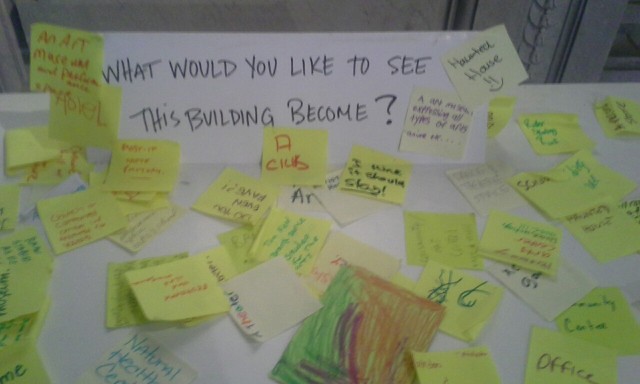
Upon exit
The show does better when it sticks to the art. Here are my highlights, along with some general observations.
When You Cut Into the Present the Future Leaks Out closes June 19, 2015.

Shellyne Rodriguez’s “Allegory for Hope or Despair.” 2014, is remarkable. An adult man cut down, or rising up from a pedestal.

Melissa Calderón’s embroidered threads that weave tongue-in-cheek stories about the “South Bronx Gold Rush of 2015.”
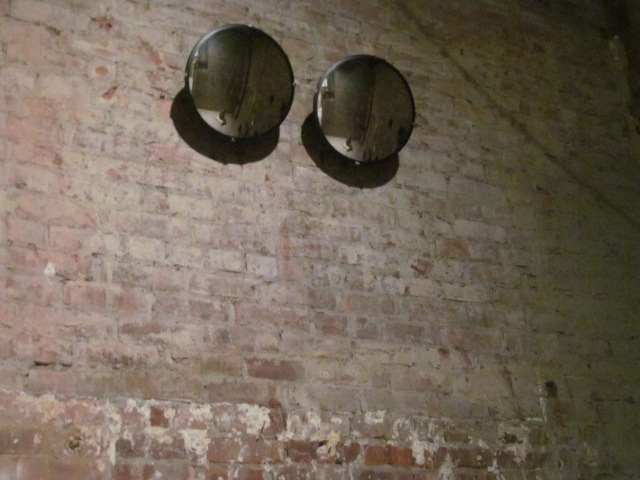
Beth Campbell, “Mirror Mirror,” 2014. Two security mirrors, stationed high up on the walls.
These are exactly the same type of mirrors you’ll see in a bodega, 99-cent store, or any establishment that relies on old-fashioned eyesight to contain crime, rather than any newfangled security system. But up high on the wall, there’s really no surveillance function. Which is too bad, because surveillance remains a strong association with these mirrors.
From the work’s wall label:
“In Campbell’s recent installation and sculpture, what appears at first glance to be a facsimile of the everyday reveals startling complexity upon further inspection—forms repeat and stutter, mirrors become portals, interiority is externalized. The familiar transforms into strange and precisely staged tableaux.”
The mirrors are not strange; they’ve been placed up high.
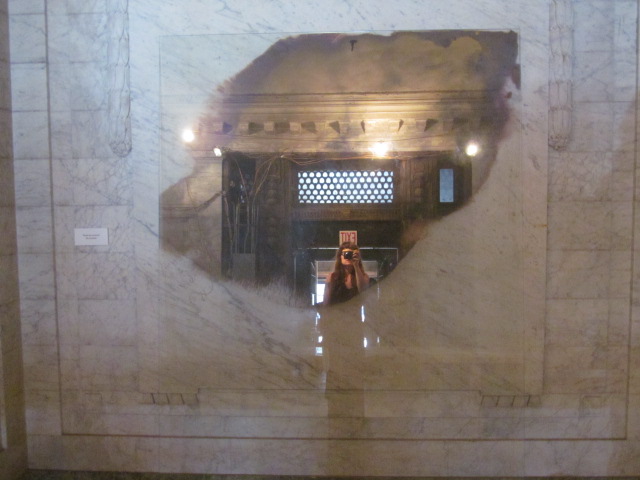
Michelle Lopez’s “Smoke Cloud I,” 2014. A beautiful, reflective surface, reminiscent of a fool’s gold burn. I’m a fan.
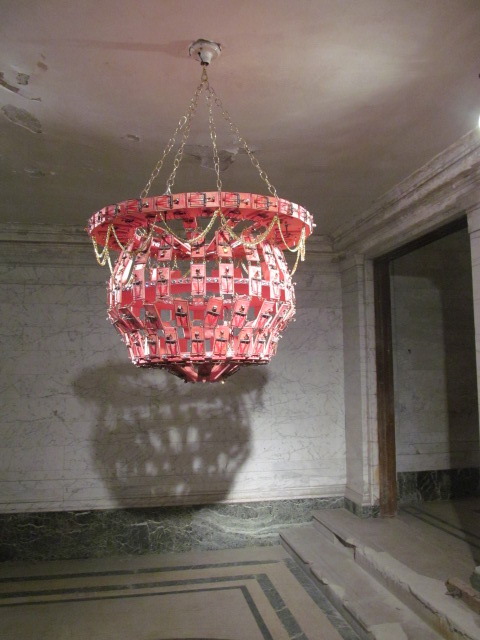
Here is a chandelier made out of mousetraps by Shellyne Rodriguez. Like the security mirrors, this is another instance of taking away an object’s previous function to give it an aesthetic one.
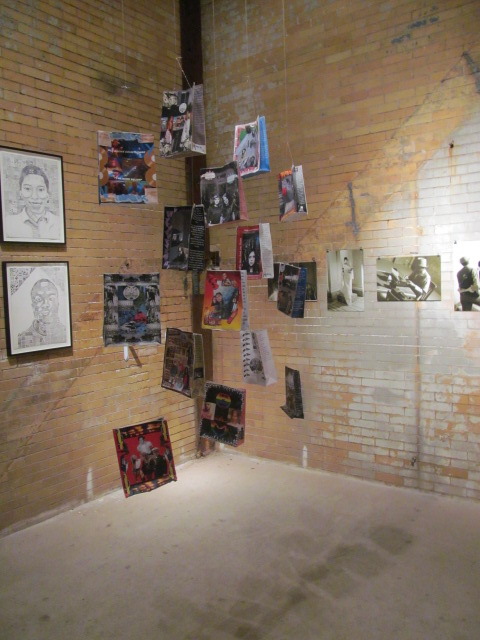
The exhibition had several rooms of work by high-school students. These paper bags were collaged by students to tell stories about neighborhood history. They twirl as they hang, as if they’re dancing. It’s a nice touch.
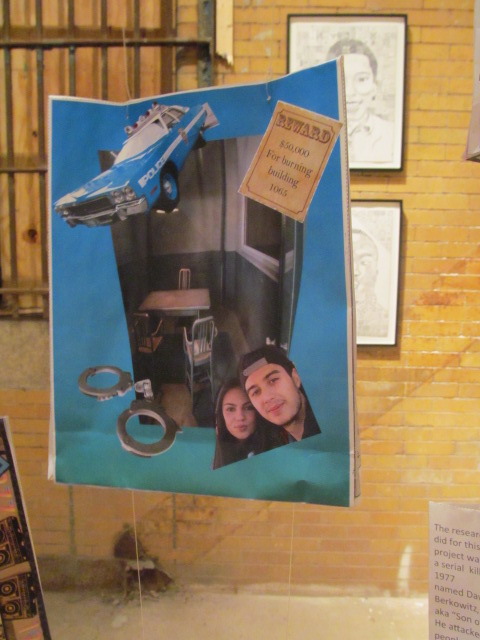
I’m a sucker for anything Internet-blue.
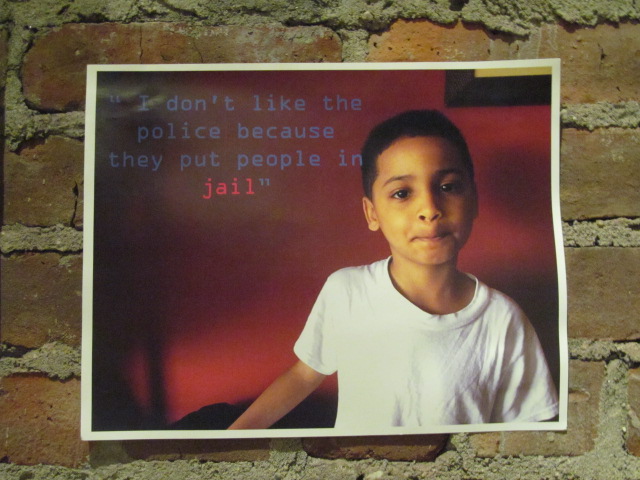
Something else that’s great about teenagers’ art: it’s straightforward. Photograph from Samantha Guzman’s “Justice?” series. Guzman is in 11th grade at Manhattan Hunter Science High School.

[NSFW] Something about “Lady Justice” wearing a dildo (because women aren’t powerful enough without one?). Artist Paco Cao and the Ghetto Film School worked on this film together. A statue of Lady Justice resides on the building’s exterior; currently it remains covered up by scaffolding.

No Longer Empty addresses the problem of redlining


Comments on this entry are closed.